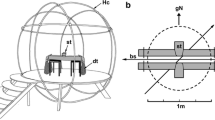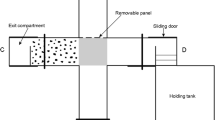Summary
Two groups ofEurycea lucifuga were trained to move bidirectionally within separate training corridors by alternately supplying moisture to limestone-filled compartments located at each end. Both corridors were aligned horizontally along the magnetic North-South axis of the earth. One corridor was enclosed within a cube coil which rotated the magnetic field horizontally 90° clockwise, so that the group contained in this corridor moved perpendicular to the North-South axis of the magnetic field. The other corridor was in the normal earth's field so that this second group moved parallel to the horizontal North-South component of the magnetic field. Testing involved releasing both groups in the center of a cross-shaped testing assembly made up of the two training corridors. The two groups were confined together in a release device for 60 min before release. In several tests the two groups were significantly oriented (P<0.05) along the appropriate trained axes with respect to the normal or altered magnetic field. Movements in these tests did not reflect a consistent response to any other potential source of orientation cues (P<0.001). It is concluded that cave salamanders are able to (1) perceive the earth's magnetic field and (2) exhibit a directional response with respect to a magnetic field which indicates a learned relationship to the environment.
Similar content being viewed by others
References
Adler, K.: Extraocular photoreception in amphibians. Photochem. Photobiol.23, 275–298 (1976)
Akoev, B.N., Ilyinsky, O.B., Zadan, P.M.: Responses of electroreceptors (ampullae of Lorenzini) of skates to electric and magnetic fields. J. comp. Physiol.106, 127–134 (1976)
Andrianov, G.N., Brown, G.R., Ilyinsky, O.B.: Responses of central neurons to electrical and magnetic stimuli of the ampullae of Lorenzini in the black sea skate. J. comp. Physiol.93, 287–299 (1974)
Bishop, S.C.: Handbook of salamanders. Ithaca, New York: Cornell University Press 1943
Blakemore, R.: Magnetotactic bacteria. Science190, 377–379 (1975)
Branover, G.G., Vasil'yev, A.S., Gleiser, S.I., Tsinober, A.B.: A study of the behavior of cells in natural and artificial magnetic fields and an analysis of its reception mechanism. J. Ichthyol.11, 608–614 (1971)
Brown, F.A.: Some orientational influences of nonvisual terrestrial electromagnetic fields. Ann. N.Y. Acad. Sci.188, 224–241 (1971)
Brown, G.R., Andrianov, G.N., Ilyinsky, O.B.: Magnetic field perception by electroreceptors in the black sea skates. Nature249, 178–179 (1974)
Emlen, S.T., Wiltschko, W., Demong, N.J., Wiltschko, R., Bergman, S.: Magnetic direction finding: Evidence for its use in migratory indigo buntings. Science193, 505–508 (1976)
Ferguson, D.E.: The sensory basis of amphibian orientation. Ann. N.Y. Acad. Sci.188, 30–36 (1971)
Ferguson, G.A.: Statistical analysis in psychology and education: New York: McGraw-Hill 1959, 1966
Green, N.B., Brant, P. Jr., Dowler, B.:Eurycea lucifuga in West Virginia: Its distribution, ecology and life history. Proc. W. Va. Acad. Sci.39, 297–304 (1967)
Hutchison, V.H.: The distribution and ecology of the cave salamander,Eurycea lucifuga. Ecol. Mono.28 (1), 1–20 (1958)
Kalmijn, A.J.: The detection of electric fields from inanimate and animate sources other than electric organs. In: Handb. sens. physiol., III/3 (ed. E.A. Fessard). Berlin-Heidelberg-New York: Springer 1974
Keeton, W.T.: Magnets interfere with pigeon homing. Proc. nat. Acad. Sci. (Wash.)68, 102–106 (1971)
Keeton, W.T.: Effects of magnets on pigeon homing. Aminal orientation and navigation. NASA SP-262 pp. 579–594 (1972)
Keeton, W.T., Larkin, T.S., Windsor, D.M.: Normal fluctuations in the earth's magnetic field influence pigeon orientation. J. comp. Physiol.95, 95–103 (1974)
Lindauer, M., Martin, H.: Magnetic effect on dancing bees. Animal orientation and navigation. Nasa SP-262 pp. 559–568 (1972)
Merkel, R.W., Wiltschko, W.: Magnetismus und Richtungsfinden zugunruhiger Rotkehlchen (Erithacus mbecula). Vogelwarte23, 71–77 (1965)
Phillips, J.B.: Possible use of weak magnetic fields by orienting salamanders (Abstract). Herpetol. Rev.7, 95–96 (1976)
Rommel, S.A., Jr., McCleave, J.D.: Sensitivity of American eels (Anguilla rostrata) and Atlantic salmon (Salmo salar) to weak electric and magnetic fields. J. Fish. Res. Board Can.30, 657–663 (1973)
Rubens, S.M.: Cube surface coil for producing a uniform magnetic field. Rev. Sci. Inst.16(9), 243–245 (1945)
Smith, J.: Hearing in terrestrial urodeles: A vibration-sensitive mechanism in the ear. J. exp. Biol.48, 191–205 (1968)
Southern, W.E.: Gull orientation by magnetic cues: A hypothesis revisited. Ann. N.Y. Acad. Sci.188, 295–311 (1971)
Southern, W.E.: Orientation of gull chicks exposed to project sanguine's electromagnetic field. Science189, 143–145 (1975)
Walcott, C.: The navigation of homing pigeons: Do they use sun navigation. Animal Orientation and Navigation. NASA SP-262 pp. 283–292 (1972)
Walcott, C., Green, R.P.: Orientation of homing pigeons altered by a change in the direction of an applied magnetic field. Science184, 180–182 (1974)
Wiltschko, W.: Über den Einfluß statischer Magnetfelder auf die Zugorientierung der Rotkehlchen (Erithacus rubecula). Z. Tierpsychol.25, 537–559 (1968)
Wiltschko, W.: The influence of magnetic total intensity and inclination on directions preferred by migrating European robins (Erithacus rubecula). Animal orientation and navigation. NASA SP-262 p. 569–578 (1972)
Wiltschko, W.: Der Magnetkompaß der Gartengrasmücke (Sylvia borin). J. Ornithol.115, 1–7 (1974)
Wiltschko, W., Wiltschko, R.: Grasmücken benutzen den Magnetkompaß auch bei Sternsicht. Naturwissenschaften52, 104–105 (1973)
Wiltschko, W., Wiltschko, R.: The interaction of stars and magnetic field in the orientation system of night migrating birds. I. Autumn experiments with European warblers (Gen. Sylvia). Z. Tierpsychol.37, 337–355 (1975a)
Wiltschko, W., Wiltschko, R.: The interaction of stars and magnetic field in the orientation system of night migrating birds. II. Spring experiments with European robins (Erithacus rubecula). Z. Tierpsychol.39, 265–282 (1975b)
Wiltschko, W., Wiltschko, R.: Interrelation of magnetic compass and star orientation in nightmigrating birds. J. comp. Physiol.109, 91–99 (1976)
Author information
Authors and Affiliations
Additional information
I thank the following people for assistance in carrying out this work: Dr. Kraig Adler and Mr. Timothy Murphy helped in the collection of the animals. Mr. David Lank, Mr. Crispin Miller, Ms. Deborah Olsen and Mr. Thomas Quinn provided aid at various times during the course of the experiment. Dr. Kraig Adler, Dr. Stephen T. Emlen, Dr. William T. Keeton, Dr. Jacob
Kiepenheuer, Mr. David Lank, Dr. Norman Meinkoth, Mr. Thomas Quinn, Dr. Kenneth Rawson and Dr. Wolfgang Wiltschko provided helpful comments and criticisms. Dr. Kraig Adler, Dr. Jacob Kiepenheuer and Dr. Klaus Schmidt-Koenig read earlier drafts of this manuscript.
Rights and permissions
About this article
Cite this article
Phillips, J.B. Use of the earth's magnetic field by orienting cave salamanders (Eurycea lucifuga). J. Comp. Physiol. 121, 273–288 (1977). https://doi.org/10.1007/BF00609616
Received:
Issue Date:
DOI: https://doi.org/10.1007/BF00609616




